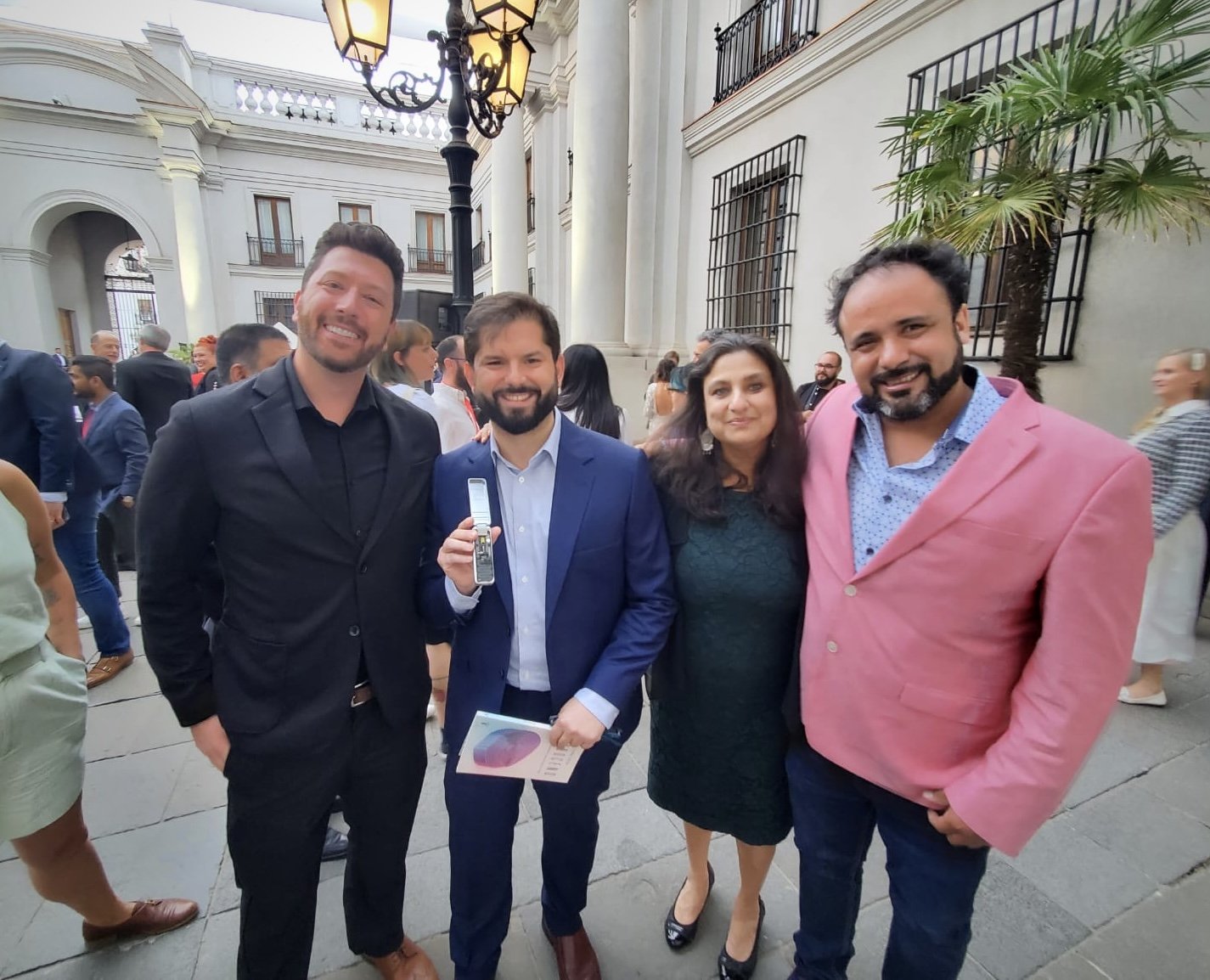On January 14, 2023, I had the opportunity to visit Antarctica with a cohort of invited speakers for an event called ‘Congreso Futuro’ in Chile. For the excursion, I teamed up with another scientist, Matías Gutiérrez, to perform ultra-fast DNA sequencing on-site, using entirely portable laboratory equipment. The objective was to demonstrate that it was possible to collect a small amount of the Antarctic soil and begin sequencing genetic information of the microbes present within the environment, all in less than one hour.
Holding up the portable ‘MinION Mk1C’ device in Antarctica. The screen shows a live interface of the DNA sequencing taking place right then and there.
Upon arrival, we managed to analyze environmental samples associated with moss and lichen, which we collected near the Professor Julio Escudero base of the Chilean Antarctic Institute. Historically, an experiment like this could take several weeks from sample collection in a remote area to analysis in a molecular biology laboratory. Obtaining the answers to research questions in extreme places like Antarctica allows scientists to investigate and ask new questions while still there.
Matías Gutiérrez explained “This is a great milestone given that it is the first time that such rapid sequencing has been carried out in the Chilean Antarctic, but also and perhaps more important is demonstrating that any Chilean scientist can study the genetics of any biological sample, anywhere and at any time. Carrying out this sequencing in the Chilean Antarctic is a powerful testimony to the potential of this technology.”
Moss and lichens native to Antarctica. Life can not only survive in this extreme environment, it can thrive.
Why might we care about microbes that live in Antarctica? Well, no doubt Antarctica is an extreme environment. But life can still thrive here. Scientists investigate these organisms to unlock the secrets of their adaptations, such as the ability to survive incredibly cold temperatures and high levels of radiation, and we believe nanopore sequencing is a powerful tool in this toolkit to improve access to genomics and explore life on earth.
However, time is not on our side. In light of climate change, we must seek to speed up the process of scientific inquiry and make access to tools more equitable. Especially in remote regions of the planet like Antarctica, where we have probably only scratched the surface of biodiversity. This is where miniaturized and accessible sequencing technology can play a critical role, serving as a powerful tool that improves access to genomics and enables scientists around the world to obtain their own DNA sequencing devices and explore life on Earth. Even in places as remote as Antarctica.
Aaron and Matias showcasing the live DNA sequencing run, which was initiated within one hour of collecting samples in Antarctica.
The following week during the official Congreso Futuro event, the President of Chile, Gabriel Boric, hosted guest speakers one evening. While there, we had the opportunity to meet President Boric, discussed the potential of democratizing genomics, and introduced him to the portable MinION device. He was incredibly impressed by the technology and the implications of accessible DNA sequencing, especially for biodiversity and science education. During the event, President Boric noted that Chile’s 2023 budget features a 13.3 percent increase in science investment, a sign that his administration “has the conviction that science and knowledge are the pillar of our development.”
The President of Chile holding the MinION device
Finally, on Friday January 20, I delivered our invited speaker presentation, which was live streamed with >20,000 views, and the recordings are on YouTube. I’ve linked the portion of my presentation which starts at ~3:27:22 in and goes until 3:43:57 here: https://www.youtube.com/live/2hfcow4EhXo?feature=share&t=12442
The main theme of the talk was centered around how we are experiencing a revolution in our ability to obtain and understand biological information like never before, and this is in part because the tools to acquire this information, especially the information of the genome, are becoming more accessible than ever before.
We are all familiar with how computing has evolved, from what initially started out as large and complicated devices that were inaccessible to the majority. In contrast, we’re all quite aware how this has changed - we all have cell phones in our pockets now, and this has fundamentally changed our lives, especially by giving us access to digital information like never before.
Similarly, DNA sequencing technologies have also evolved. What started out as very large and expensive devices, that were relegated to a few institutions that could access these tools. But we’ve come a long way since then, and indeed we’ve also gotten to the point now where these devices for DNA sequencing can be used in the lab and even out in the field. We are beginning to realize the potential of “enabling the analysis of anything, by anyone, anywhere.“
We are thankful for the invitation and opportunity to participate in Congreso Futuro, and would like to also acknowledge the Chilean Antarctic Institute (INACH) and the Chilean Armed Forces for logistical and field support to Antarctica.















